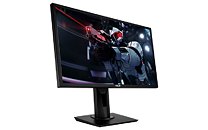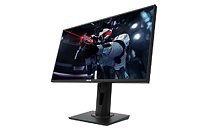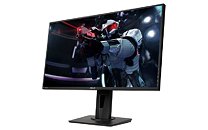Thursday, April 4th 2019

ASUS Announces Three New G-Sync Compatible Monitors With 0.5 ms Response Times and 165 Hz Refresh Rates
ASUS has launched three new monitors that are being marketed as G-Sync compatible - not as FreeSync-capable. These span three diagonal sizes in the form of the 27-inch VG278QR, the 24.5-inch VG258QR, and the 24-inch VG248QG. All share the same 1,920 x 1,080, TN panels that boast of blazing fast response times (ASUS quotes 0.5 ms), and high-ceiling refresh rates of 165 Hz for fluid gameplay. Additionally, ASUS claims they take their G-Sync Compatible monitors through a two-stage certification process in close communication with NVIDIA, which ensures these are some of the best Adaptive Sync monitors you can buy for usage with NVIDIA's cards.
All monitors feature ASUS' GameVisual presets that adjust screen settings according to the type of game you're playing. They also feature ASUS Extreme Low Motion Blur (ELMB) for flickering reduction. On the ergonomics side of the equation, all three monitors support tilt, swivel, pivot, and height adjustments, and I/O is handled by 1x DisplayPort 1.2, 1x HDMI (v1.4), 1x Dual Link DVI-D, 1x Earphone Jack Audio in.
Sources:
via Hardware Zone, via Menafn
All monitors feature ASUS' GameVisual presets that adjust screen settings according to the type of game you're playing. They also feature ASUS Extreme Low Motion Blur (ELMB) for flickering reduction. On the ergonomics side of the equation, all three monitors support tilt, swivel, pivot, and height adjustments, and I/O is handled by 1x DisplayPort 1.2, 1x HDMI (v1.4), 1x Dual Link DVI-D, 1x Earphone Jack Audio in.



33 Comments on ASUS Announces Three New G-Sync Compatible Monitors With 0.5 ms Response Times and 165 Hz Refresh Rates
So yeah, disappointment is natural.
Acer, AOC, Benq also released new models with these panels. LG and ViewSonic still using the old panel on all their models.
Also the contrast is a major improvement on these 24,5 AUO 144hz/165hz panels, so are the colours. While the old and usual AUO 24´120hz panel (wich companies overclocked to 144h) had really bad colours and contrast, wich got worse with the 24hz overclock.
Now, these monitors are not geared towards single player gamers for sure. For those, the new Gigabyte Aorus AD27 is a "must" have, IPS 144hz 27 inch 1440p new screen with HDR. These TN panels are for people that spend their time on multiplayer games like Apex, Fortnite, Pubg or Call of Duty.
165hz is a great refresh rate and noticeable compared to 144hz. Also sustaining 160fps is pretty easy on most engines nowadays with modest CPUs. That delivers enough frame times for consistent aim and low input lag.
The one thing that makes my monitor truly crap is the inability to run at higher refresh rates without issues. Alas, I noticed it too late to return it.
I had an IPS and VA before my current high refresh TNs and while they produce very nice colors they've flaws that come out in everyday use.Exploring caves in witcher 3 on an IPS looked ridiculous given how much it cost me (more than my 165hz TN for a 60hz IPS),dark scenes were silver&yellow with something resembling black only in the center.The VA that I had produced so much smearing that switching to an IPS felt like +10 fps more already,and the only way to solve that is either a native 120hz VA panel or one that does ulmb/other motion blur reduction.